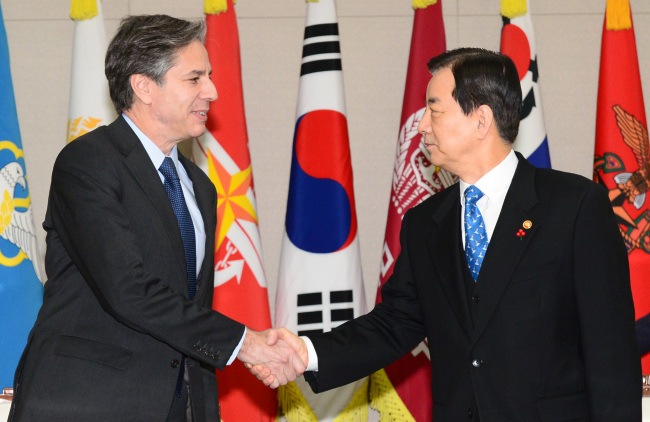[News Analysis] Missile shield dispute rekindled
Security experts say S. Korea, U.S. moving in direction of integration
By KH디지털2Published : Jan. 26, 2016 - 15:22
The plan by South Korea and the U.S. to set up a real-time missile-related intelligence-sharing mechanism is rekindling a controversy over whether the former is moving closer to participating in America’s global missile shield program despite China’s persistent objections.

After North Korea carried out what it claims to be a hydrogen bomb test earlier this month, the allies announced the plan as part of their efforts to strengthen defense against Pyongyang’s evolving nuclear and missile threats.
The intelligence-sharing mechanism is to be established through the “Link-16” system that connects Seoul’s interface control center with that of the U.S. to enable real-time intelligence-sharing, Seoul officials explained.
Given that the U.S. has a similar intelligence-sharing apparatus with Japan, the South’s intelligence can also flow into Japan, which would strengthen both bilateral and trilateral security cooperation among the three nations.
Although Seoul’s Defense Ministry said that the allies’ scheme of intelligence-sharing does not mean South Korea’s participation into the U.S. MD program, analysts noted that the new intelligence cooperation plan reaffirmed that the allies are heading toward the integration of their hitherto separate missile defense programs.
“There has already been progress in the allies’ efforts to integrate their air and missile defense programs, although there have been some limits in the efforts due to the political considerations vis-a-vis China,” said Park Won-gon, security expert at Handong Global University.
“Given that under a current war plan, the allies are to operate combined air forces, it would be difficult to carry out wartime aerial operations should the two sides have separate air defense programs that are hardly interoperable.”
Nam Chang-hee, defense expert at Inha University, also said that strictly from a military standpoint, real-time intelligence-sharing would optimize the allies’ air defense system and enhance the credibility of their shared military intelligence.
“Given that South Korea’s envisioned ‘Kill Chain’ preemptive strike system would not be able to strike all North Korean targets, particularly road-mobile ones, it is important to further strengthen our defense capabilities,” he said.
“In light of this, enhanced missile defense cooperation among the allies, as well as Japan, would be an optimal way (of coping with the North’s missile threats). The allies seem to be moving in that direction gradually, although the Seoul government keeps a cautious stance on the surface in consideration of its relations with Beijing.”
The U.S. has long demanded the South join its missile defense initiative. But the South has remained reluctant for fear that its participation in the initiative would strain ties with China and Russia, which believe that any U.S. missile defense asset in the South could potentially target them.
In recent years, Washington has expressed its desire to install its Terminal High Altitude Area Defense system on the peninsula. In response, Seoul had been cautious, showing reluctance to openly touch on the issue.
Recently, however, the Seoul government, including Defense Minister Han Min-koo has commented on the issue, telling a news program Monday that it was worth reviewing the THAAD dispatch from the defense perspective.
Signs of Seoul’s moves toward joining Washington’s MD program have already been detected. One was to develop the allies’ tailored deterrence strategy and operational plans based on the “4D” concept -- detect, defense, disrupt and destroy.
“Detect” represents the allies’ procedures to track North Korea’s missile movements with various intelligence-gathering assets, while “defense” refers to a set of allied defensive operations to minimize any damage from potential attacks.
“Disrupt” includes striking North Korea’s core missile facilities, such as support installations, followed by the allies’ efforts to “destroy” its mobile transporter-erector-launchers and incoming missiles.
The 4D concept involving offensive missions appears to be part of the U.S.’ Integrated Air and Missile Defense program, under which Washington has sought to involve its key allies including Tokyo to build a comprehensive missile shield.
Designed to better respond to diverse air and missile threats from potential adversaries, rogue states such as North Korea, and even non-state actors such as terrorists, the IAMD involves a wide range of both offensive and defensive capabilities -- a departure from the previous defense-oriented MD program.
As the U.S. has been pushing for the IAMD in a fiscally constrained environment, it has sought cooperation with its allies, particularly Japan, in establishing and expanding the IAMD coverage, and ensuring interoperability with the systems of its allies.
Critics here said that Seoul should be cautious in integrating its missile defense program with that of the U.S., as it could further fan the Cold War-like tensions in the region with China likely to seek stronger military ties with Russia.
By Song Sang-ho (sshluck@heraldcorp.com)










![[Hello India] Hyundai Motor vows to boost 'clean mobility' in India](http://res.heraldm.com/phpwas/restmb_idxmake.php?idx=644&simg=/content/image/2024/04/25/20240425050672_0.jpg&u=)








